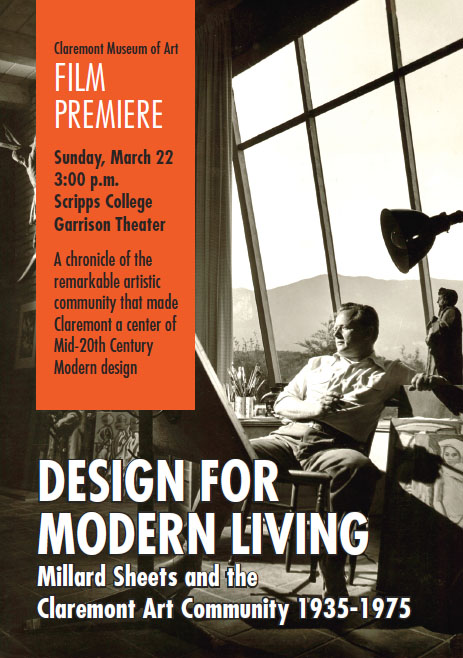Event: Past
Film Premiere of Design for Modern Living: Millard Sheets and the Claremont Art Community 1935–1975
Garrison Theater at Scripps College
,
Design for Modern Living Premieres at Garrison Theater

DVDs of the film Design for Modern Living are available from Paul Bockhorst Productions. BUY DVD.
Sponsored by the Claremont Museum of Art, the Clark Humanities Museum and the Ruth Chandler Williamson Gallery at Scripps College
An enthusiastic crowd of over 600 filled Garrison Theater for the premiere of Design for Modern Living: Millard Sheets and the Claremont Art Community 1935-1975 on Sunday, March 22. The one-hour documentary film, produced by Paul Bockhorst in partnership with the Claremont Museum of Art, provides a vivid and illuminating account of the important art community that emerged in Claremont in the years following World War II under the leadership of Millard Sheets, with profiles of nearly two dozen artists and craftspersons.
The premiere event, sponsored by the Claremont Museum of Art, the Clark Humanities Museum and Ruth Chandler Williamson Gallery at Scripps College, included an introduction by filmmaker Paul Bockhorst, a Q&A session and a wine reception to benefit CMA programs. Thanks to promotion sponsors Wheeler Steffen Sotheby’s International Realty and Ryan Zimmerman, Broker Associate, Wheeler Steffen Sotheby’s International Realty.
DESIGN FOR MODERN LIVING
In the years following World War II, the community of Claremont in Southern California emerged as an important center for the visual arts, due in large measure to the inspired efforts of the artist and educator Millard Sheets. In Claremont, painters, sculptors, ceramists, enamel and mosaic artists, woodworkers and fiber artists devoted themselves to their creative pursuits with great imagination and energy, creating works that express the spirit of Postwar Modernism in California.
Design for Modern Living tells the story of the remarkable artistic community that took root at Scripps College and made Claremont an important center of Mid-20th Century Modern design.

“The interviews touch on all the important issues and are beautifully integrated with the historic photographs. Congratulations on a fine job extraordinarily well done!” – Harold Nelson, Curator of American Decorative Arts, The Huntington Library, Art Collections, and Botanical Gardens
In the film, artists who were active in Claremont in the postwar period share their memories of the time and place. They include Betty Davenport Ford, John Svenson, James Strombotne, Paul Darrow, Harrison McIntosh, Barbara Beretich, and Martha Longenecker. Other artists featured in the documentary include William Manker, Jean and Arthur Ames, Albert Stewart, Henry Lee McFee, Phil Dike, Milford Zornes, James Hueter, Jack Zajac, Karl Benjamin, Roger Kuntz, Rupert Deese, Susan Hertel, and Sam Maloof. Additional insights are provided by Tony Sheets, Carolyn Sheets Owen-Towle, Christy Johnson, Harold Nelson, James Elliot-Bishop, and Catherine McIntosh.

The documentary was produced by Emmy Award-winning producer Paul Bockhorst, in cooperation with the Claremont Museum of Art. A veteran writer, producer, and director, Bockhorst has produced dozens of documentary, informational, and public affairs programs that have appeared on PBS, NBC, ABC, Turner Broadcasting, and the Disney Channel. He is the recipient of numerous professional awards, including five Emmy Awards.
Principal funding for Design for Modern Living was provided by The Ahmanson Foundation and Howard and Roberta Ahmanson, The Windgate Charitable Foundation, Gerald and Bente Buck, E. Gene Crain, Marguerite and Harrison McIntosh, Tom & Carolyn Sheets Owen-Towle, and the Family of Helen Bockhorst. Additional support was provided by the Historical Collections Council of California, Peter and Gail Ochs, Robert and Nadine Hall, Jim and Perry Jamieson, Beverly Maloof, the Family of Karl Benjamin, and Betty Davenport Ford and Harold Ford.

CLAREMONT: A CENTER FOR MODERN DESIGN
The three decades following the end of World War II stand out as a golden age in Claremont and the surrounding Pomona Valley. The work created in that time and place gave vibrant physical expression to Southern California’s informal lifestyle, commanding both national and international attention.
American confidence was high, and so too was the desire for the good life promised in the American Dream. After fifteen long years of economic crisis and war, there was enormous pent-up demand for modern housing and well-designed home furnishings. Another important factor was the GI Bill, which allowed large numbers of returning veterans unprecedented access to higher education, including art instruction. The alignment of these factors in the late 1940s and early 1950s set the stage for an explosion in craft production in Southern California—and for Claremont’s emergence as an important center for modern design.
MILLARD SHEETS: ADVOCATE FOR THE ARTS
If the conditions were favorable for an artistic boom, a spark was still needed to ignite it. Millard Sheets was at once a painter, a muralist, an architectural designer, a teacher and art administrator, an entrepreneur, and an inspired cheerleader who tirelessly preached the importance of art in daily life. Handsome and energetic, daring and resourceful, he was a passionate ambassador for the arts. Sheets began by creating the art department at Scripps College and the Claremont Graduate School in the 1930-40s. He went on to develop the Art Department at the Los Angeles County Fair, planned and designed dozens of Home Savings & Loan Association branches throughout California, and became a powerful voice for the arts in the Southland.
We were pleased to premiere this film on Sunday, March 22, 2015 at Garrison Theater, a structure designed by Millard Sheets in 1962 featuring his distinctive mosaic murals.

PAUL BOCKHORST: PRODUCER‘S STATEMENT
Paul Bockhorst, a veteran writer, producer, and director, has produced dozens of programs that have appeared on PBS, NBC, ABC, Turner Broadcasting, and the Disney Channel. He recently received an Honorary AIA Award for his many documentaries on art and architecture.
I have long been fascinated by the unique art community that developed in Claremont in the years following World War II. I’ve often marveled at the wide range of art and craft produced there and the high caliber of that work. Artists like Millard Sheets, William Manker, Albert Stewart, Betty Davenport Ford, Karl Benjamin, Jack Zajac, Roger Kuntz, Harrison McIntosh, and Sam Maloof set high standards and made Claremont a major center for art, craft, and architecture in the postwar period. Several times over the years I considered making a documentary about that community, with an emphasis on the leadership role played by Millard Sheets. Then, in 2012, I realized the urgency of the project and the need to act while a number of artists from that period were still able to provide firsthand accounts. To that end, I joined forces with the Claremont Museum of Art and embarked upon the production of a major documentary.
The first priority was to locate and interview surviving artists from the 1950s and 60s. Many were elderly, and it was important to move quickly to capture their memories. After securing a research grant from the Windgate Charitable Foundation, I proceeded to conduct interviews with a number of artists. They provided vivid and illuminating perspectives on what has been called the golden age of art in Claremont. People interviewed in the initial phase of the project included John Svenson, Betty Davenport Ford, Harrison McIntosh, Martha Longenecker, Paul Darrow, James Strombotne, Tony Sheets, Carolyn Sheets Owen-Towle, Rufus Turner, and Barbara Beretich, among others.
As I pursued the project, I found an enormous amount of material—so much, in fact, that the scope and complexity of the story seemed to expand with every step I took. I realized that there was too much material for a single one-hour documentary. After consulting with project partners, I decided to divide the material and make not one, but two documentaries. The first, Design for Modern Living: Millard Sheets and the Claremont Art Community, 1935-1975, focuses on art and craft in Claremont, and is being done in cooperation with the Claremont Museum of Art. The second documentary, Claremont Modern: The Convergence of Art + Architecture at Midcentury, is being produced in association with Claremont Heritage. It examines modern architecture and design. Together, the two documentaries provide a comprehensive panorama of art, craft, architecture, and design in Claremont in the postwar period.

